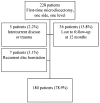The risk of "getting worse" after lumbar microdiscectomy
- PMID: 15138862
- PMCID: PMC3476683
- DOI: 10.1007/s00586-004-0721-5
The risk of "getting worse" after lumbar microdiscectomy
Abstract
A frequent concern among patients operated for lumbar disc herniation is the risk of "getting worse". To give an evidence-based estimate of the risk for worsening has been difficult, since previous studies have been more focused on unfavourable outcome in general, rather than on deterioration in particular. In this prospective study of 180 patients, we report the frequency of and the risk factors for getting worse after first time lumbar microdiscectomy. Follow-up time was 12 months. Primary outcome measure was the Oswestry disability index, assessing functional status and health-related quality of life. Of the patients 4% got worse. Independent risk factors of deterioration were a long duration of sick leave and a better functional status and quality of life prior to operation. We conclude that the risk of deterioration is small, but larger if the patient has been unable to work despite relatively small health problems. This study also demonstrates that changes in instrument scores should be reported, so that an accurate failure rate can be assessed.
Figures
Comment in
-
The Michel Benoist and Robert Mulholland yearly European Spine Journal review: a survey of the "surgical and research" articles in the European Spine Journal, 2005.Eur Spine J. 2006 Jan;15(1):8-15. doi: 10.1007/s00586-005-1062-8. Epub 2006 Jan 13. Eur Spine J. 2006. PMID: 16411129 Free PMC article. Review. No abstract available.
-
The Michel Benoist and Robert Mulholland yearly European Spine Journal Review: a survey of the "medical" articles in the European Spine Journal, 2005.Eur Spine J. 2006 Jan;15(1):2-7. doi: 10.1007/s00586-005-1061-9. Epub 2006 Jan 13. Eur Spine J. 2006. PMID: 16411130 Free PMC article. Review. No abstract available.
References
-
- Abramovitz Neurosurgery. 1991;29:301. - PubMed
-
- Asch J Neurosurg. 2002;96:34. - PubMed
-
- Baker DJP, Pynsent PB, Fairbank CT (1990) The Oswestry disability index revisited: its reliability, repeatability and validity, and a comparison with the St Thomas’s disability index. In: Roland M, Jenner JR (eds) Back pain. New approaches to rehabilitation and education. Manchester University Press, Manchester, pp 174–186
-
- Brazier Health Technol Assess. 1999;3:1. - PubMed
-
- Carmines EG, Zeller RA (1979) Reliability and validity assessment. Quantitiative applications in the social sciences #17. Sage Publications, Newbury Park, CA
MeSH terms
LinkOut - more resources
Full Text Sources
Medical


